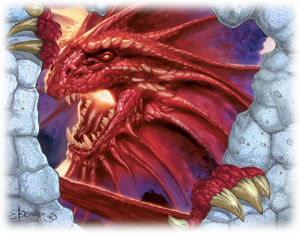Now we’re down to the finale, at least until someone shows me a good Eye of the Storm deck, so I can write a combo article. These are generally the decks that gained the most from the newer Dissension cards. However, many of the older control designs have generally been deemed inferior to BWG Good Stuff, which caused much sadness across the land. As Teacher Kitano would say though, “Fight for survival and see if you’re worth it.”
With that quote in mind, that really only leaves us with a few decks to delve into: UGR Twister, UWR Firemane, and something with Niv-Mizzet.
UGR Twister
Short of the new archetypes that Dissension has spawned, this archetype seems to have gained the most from the set, thanks to the Simic improvements to Sky Swallower. Other than him, the deck also gained Voidslime and… okay, nothing else from Dissension. However, Breeding Pool and Simic Growth Chamber now allow for easier Savage Twister casting, and more potential board options like Indrik Stomphowler.
The archetype has two big things going for it…
1. The Quality of Finishers
You have Simic Sky Swallower; Niv-Mizzet, the Firemind; and potentially Demonfire or Invoke the Firemind.
2. Removal and Protection
You have the best board sweeper in the format in Savage Twister, and a way to find it (Muddle the Mixture). In addition, you’ve got Remand, Muddle the Mixture, Convolute, and Voidslime forming your counter base.
The deck’s strategy is relatively simple: play some mana acceleration early on, and respond to threats as they appear. However there are some general questions you should have some idea about before each match.
1. How often you should hold back Savage Twister for a higher return (i.e. killing more creatures)?
2. Do you know when you can afford to tap out for card drawing or Transmute without getting unnecessarily hit by burn or a creature too big to Twist out?
3. Do you know when to shift from fighting an attrition war to going for the throat?
Creatures (6)
Lands (23)
Spells (31)

Possible changes to the deck:
Addition of Walls or other defensive cards — If you feel you’re lacking early game defense against the various Rakdos or Gruul decks, it may be in your best interest to cut Niv-Mizzet and Telling Time for Carven Caryatid or Drift of Phantasms, for additional stalling. Repeal is another possible choice, to stall a creature attack for a turn or two while giving you a cantrip.
High-end spells that aren’t creatures — If you notice, I built the deck specifically to only want a lot of mana for its finishers and larger Twisters. By having the deck in such a configuration, you aren’t starving for early game defense, and by mid-game you can consistently keep counters open while casting draw or search. However you could still abuse the ramp up to 6 or 7 mana by running cards like Demonfire or Invoke the Firemind. They may not be the most efficient spells in the world, but being able to renew your entire hand in one swoop, or dishing out eight for the win, is tempting.
Firemane Control
At first I was loathe to add this deck, purely because it had very limited options in dealing with Simic Sky Swallower. Though I still hold reservations about the deck being able to trump that specific threat, it at least can put up a coherent game-plan against other decks. The removal is simply tailor-made to crush smaller creatures; meanwhile, you still keep some amount of counters against other controlling decks. Not to mention Firemane Angel keeps coming back for more, no matter how many times you deal with it. Of course, who says you need to win with your own creatures? That’s what Dream Leash was made for.
Creatures (9)
Lands (23)
Spells (28)

Possible changes to the deck:
Different sets of finishers — Windreaver and Firemane Angel made it into the deck, because they happen to always come back to menace your opponents. It’s like playing a Final Fantasy, except you don’t have infinite summons. Angel dies and it haunts you from the grave, and then it comes back to beat the crud out of you two turns later. Windreaver does its best Seifer impression, and then returns to hand. Don’t even get me started on versions that fit in Skarrgan Firebird.
More controlling enchantments in the maindeck — Additional Copy Enchantments are always an option, to really abuse Fetters and Leash. Some players on MTGO have also chosen to use the plodding Searing Meditation for additional finishing power. Personally I’m not a big fan of the card, but I think anyone can see the potential late-game power of a Meditation or two combined with Firemane Angel and other life-gain effects.

Let me repeat that. Dream Leash is savage enough that people are running Copy Enchantment just to get more bootleg copies for Skeletal Vampire, Loxodon Hierarch, and Playstation 2 games. To put it bluntly, “Anything you can find that’s not nailed down is yours to keep.” *
Running actual draw — I know my version includes some amount of Compulsive Research, but I’ve seen lists that run zero. On the other side of the spectrum, there are those that run Invoke the Firemind, purely because if it’s not killing a creature it’s drawing you 3 or 4 cards. The driving factor of the importance of draw is mainly how many recurring effects you run. The more cards that cantrip like Electrolyze, or keep shooting like Meditation, or come back like Firemane, the less you worry about it.
Running actual answers — Just so everyone knows, this deck has no real answer to something like Muse Vessel, Cremate, or Rain of Gore, other than “ignore it and win.” The same goes more or less for Silhana Ledgewalker, Giant Solifuge, or Simic Sky Swallower. Yeah, eventually you could get out enough Firemanes to stop each threat, but it’s still going to be very annoying. Cards like Odds / Ends or Seed Spark may be a little expensive and narrow, but you’ll more than likely need some post-board narrow answers to help stop certain threats from simply ruining you. The real question is; do you want to leave all this on the board, or pack some maindeck stuff to help out?
Niv-Mizzet Control
So I lied. I’m listing one deck that’s “out there,” more so than the other control decks I previously mentioned. The premise of the deck is quite simple: live until you play Niv-Mizzet, and then proceed to draw cards and attack until the opponent is a bloody mess. If Niv-Mizzet dies… then it’s time for plan B. Play another Niv-Mizzet, draw cards and attack until the opponent is a bloody mess. Except this time you do it with pizzazz.
Creatures (4)
Lands (23)
Spells (33)


The deck may scare many of you, as well it should. It’s hardly been through rigorous testing, nor has it been amazing in its results. I list it because of the potential the creature, has and the number of solid cards you get from purely U/R. Yes, Niv-Mizzet is six mana, and its usefulness is dependent on other cards for maximum potential, but as JP Meyer put it on a TMD thread, “Niv-Mizzet is a Psychatog that also Wraths your opponent’s side and doesn’t force you to discard your cards.”
Now that I’ve sufficiently disappointed you on the number of viable control decks, I’ll admit I fibbed a little. I’ve also seen / heard of UGW Counter-Post, UW Azorius, and BUR Mill / Stall control all being viable in various forms. My issue for not covering these decks is quite simple: I simply don’t have any notable testing experience with them, and I have yet to locate a suitable list from another source. Charleston will almost certainly have one team with a decent list of a couple of these, so with luck you won’t have to wait long to find out what’s good and what isn’t.
Thankfully, Adrian Sullivan has covered one of the only viable combo decks in the format. As a result this leaves me with nothing left to really talk about. However before I go, I’ll just give short mention to a couple of sideboard cards that may make a splash throughout the format as decks progress.
Rain of Gore
Wipes the floor with the UWR control decks floating around, and makes decks packing Congregation at Dawn for the baby elephant plan look real silly. Such an obvious board card, yet so underplayed because of the BR cost.
Parallectric Feedback
Angel of Despair costs seven, you say? And so does Simic Sky Swallower? What about Skeletal Vampire? Six mana? Aggro decks relying on a compliment of burn would do well to consider this card for the board. Against slower decks you can easily deal ten or more damage just from one of these and the various burn spells in your deck.
Muse Vessel
Hey, Disrupting Scepter saw play in some formats! Though I’d hardly consider it the greatest drop in the world, it’s a non-creature threat that can get active on turn 4 and start tearing apart hands.
Nightmare Void
Again, it’s solid against slower control decks since most of these decks lack real card draw. Void will essentially allow you to run an attrition war on your own terms.
That’s all for now. Good luck to anyone attending Charleston (Feinstein and Brassy, this means you!), and have fun with RBC.
Josh Silvestri
Team Reflection
Email me at: JoshDOTsilvestriATgmailDOTcom
